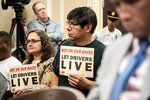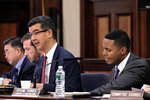A few of our stories and columns are now in front of the paywall. We at The Chief-Leader remain committed to independent reporting on labor and civil service. It's been our mission since 1897. You can have a hand in ensuring that our reporting remains relevant in the decades to come. Consider supporting The Chief, which you can do for as little as $3.20 a month.


For years Bhairavi Desai, co-founder and executive director of the New York Taxi Workers Alliance, prodded elected officials to pay attention to the plight of her members who were hopelessly trapped by predatory loans for as much as $1 million that they took out to buy taxi medallions.
They finally did at a standing-room-only June 24 hearing of the City Council’s Transportation and Oversight Committees. It came after several driver suicides and an exposé by the New York Times that uncovered the role of city officials in helping to stoke a medallion market relying on usurious loans that snared thousands.
Too Sweet to Question?
Ms. Desai, 46, and the NYTWA had long warned that the system was rigged and the city was ignoring the situation because it was raking in hundreds of millions of dollars in revenue from the medallions, which in theory were supposed to grant the owners the exclusive legal right to pick up riders who hailed them on city streets.
Thousands of drivers, many of them immigrants, saw the taxi medallion as their first step towards realizing the American Dream. They were not daunted by the long hours they would need to drive, nor the challenges involved in finding others to whom they could lease their cabs while they were resting.
As early as 2004, Ms. Desai said during a City Hall interview, her members were warning “that there was not enough work out there for the city to auction off yet more medallions.”
City Reaped $855M
Their concerns went unheeded as the Bloomberg and de Blasio administrations brought in $855 million in revenue by auctioning off additional medallions and collecting taxes on the private transfers of them, according to The Times.
Its investigation disclosed that behind the scenes “a handful of taxi industry leaders artificially inflated medallion prices and made hundreds of millions of dollars by channeling immigrant buyers into reckless loans.”
As a consequence, the Times reported, medallion prices spiked to $1 million in 2014, up from $200,000 in 2002, as local credit unions “adopted tactics similar to those in the housing crash, issuing loans with exploitative terms to low-income drivers who could not afford them.”
Ms. Desai said that the structure of the medallion-financing scandal closely mirrored the mortgage meltdown precipitated by Wall Street more than a decade ago.
“What we saw from the Times investigation was that these credit unions were encouraging owner/drivers to buy at a high value even as they were selling off the same loans and getting rid of their own liability,” she said. “During the housing crisis we knew it was private banks, many of them large banks, that were involved, but these were credit unions that are supposed to be member-driven.”
At the same time that the Bloomberg administration persisted in peddling taxi medallions, the growth of on-line ride-hailing apps like Lyft and Uber further undermined the value of the medallions. For years, the city’s highly regulated cab industry had kept the number of cabs between 12,000 and 14,000. By 2013, close to 50,000 cars were for hire. By last year, it was 100,000.
Close to 1,000 medallion owners went bankrupt, while others struggled to stay current on loan installments that far outstripped their income from driving. Defaults on loans resulted for some in foreclosures and evictions of their families.
At the hearing, Council Member Ritchie Torres, who chairs the Oversight Committee, said he had gotten an internal memo written by a city official that documented that as early as 2010, the Bloomberg administration was aware that the run-up in medallion prices was unsustainable. Council Members have committed to find some relief for the drivers.
‘A Government Scandal’
“The collapse of the medallion market, properly understood, should be remembered as one of the greatest government scandals in the history of New York City,” Mr. Torres said at the start of the proceeding. “The medallion market collapse is a cautionary tale of what happens when both government and markets are governed not by laws but by greed.”
In many ways the hearing, and the extensive media coverage it generated, were an important inflection point for a labor group that Ms. Desai and her colleague Javaid Tariq founded in 1998 that now has more than 22,000 members, with affiliates in Philadelphia, Austin and San Francisco.
NYTWA membership includes Yellow-cab owner/operators, livery drivers, black-car drivers, and Lyft and Uber drivers.
“We have had this unity campaign and we were the same folks on May 8 with the global strike [against Uber/Lyft],” Ms. Desai said. “We have unity because fundamentally it is a race to the bottom that’s affected drivers and the entire industry, whether it’s medallion driver/owners that are steeped in debt and lost their life savings and plans for retirement or Uber and Lyft drivers caught up in their own predatory lending schemes” trying to purchase a $30,000 vehicle that ends up costing $90,000.
An Indian Immigrant
She was born in India and her family initially moved to North Carolina but settled in New Jersey in 1980. “I went to Rutgers and I studied women’s studies and labor history, and I was really interested in South African labor history and the role the Congress of South African Trade Unions played in defeating apartheid,” she said.
Her initial work out of college was with a non-profit group advocating for Southeast Asian women on issues like domestic violence.
Evidently, Ms. Desai said, she inherited her penchant for social-justice organizing from her grandmother. “I was just telling this story that about how my grandmother [who came of age in British-controlled India] was disappointed that I was never arrested for civil disobedience.”
A few days after her testimony before the City Council, she helped organize her group’s appearance at the Port Authority of New York and New Jersey’s Jersey City offices to protest a proposal to add a $4 fee to taxi pick-ups at agency airports.
She encouraged her members to come to the podium and make their own case, something the NYTWA has made a key organizing strategy—supporting drivers to find their own voices.
‘Power When We Organize’
“It’s the workers’ movement,” she said. “You see, workers may not be in power, but we have power and when we organize, we unleash that power.”
The initial organizing started in 1996. “Since then, day and night we struggled to organize the drivers,” Mr. Tariq said. “It is a scattered labor force. It is not a factory, and there are people from over a hundred countries with different languages.”
He continued, “We are out there in the summer, in the winter, in the snow going to the airports where the drivers are hanging out, to the change of shifts at the garages, to ethnic restaurants.”
Many members come from countries with authoritarian governments where protest and labor-organizing carry serious repercussions. Mr. Tariq said part of driver engagement centers on civics.
“We are always telling them, ‘You are in the USA. You are in America,’ ” he said. “ ‘You are a hardworking, law-abiding person, so you don’t have to be afraid to speak up.’ That’s the main thing—if you don’t speak up, people will crush you.”
Joshua Freeman, a labor historian and Professor at the City University of New York Graduate Center, said the NYTWA was building on a rich tradition of immigrant organizing that is part of the American union movement’s DNA.
“Going back to the Lawrence Textile Strike in 1912, you had two dozen different languages and vastly diverse political experiences at play,” he said. “And considering that the NYTWA membership is voluntary, it is impressive how much they have accomplished.”
Mr. Freeman spent some time driving a Yellow cab in the city. “It was during the 1970s when the industry was unionized and we had contracts with fleet owners,” he recalled in a phone interview. “But all that changed when they switched to the leasing system and taxi-cab drivers fell out of that definition of being an employee.”
He continued, “That’s where the Taxi Workers Alliance has been creative: by getting to have input in how they are regulated as an alternative to collective bargaining.”
We depend on the support of readers like you to help keep our publication strong and independent. Join us.
Comments
No comments on this item Please log in to comment by clicking here